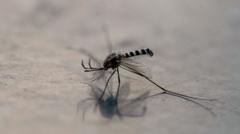In an innovative move to fight the rising incidence of dengue fever, authorities in Barangay Addition Hills, one of Manila’s most densely populated districts, are providing cash incentives for community members to catch mosquitoes. The village chief, Carlito Cernal, announced the initiative, offering one peso (less than two US cents) for every five mosquitoes captured.
As dengue cases have surged in the Philippines, spurred by recent student fatalities from the disease, the program aims to complement existing health measures. The initiative includes rewards for both live mosquitoes and their larvae, with the dead specimens also qualifying for collection. Extermination will be conducted using ultraviolet light for live catches.
Despite initial ridicule on social media, with comments mocking the scope of the bounty and questioning its effectiveness, Cernal stands firm. He emphasizes the urgent need to address health concerns in an area home to nearly 70,000 residents crammed into a 162-hectare space. He cites a recorded 44 cases of dengue in his community recently, underscoring the seriousness of the issue.
The Philippine Department of Health (DOH) acknowledged the local government's intentions but refrained from endorsing the bounty as a proven method for combating dengue. They encouraged coordination with local health officials and evidence-based practices to control mosquito populations.
Dengue, a viral illness endemic to tropical regions, is particularly concerning in urban environments with inadequate sanitation, facilitating the spread of the virus through mosquito breeding. Severe cases can lead to serious health complications, including internal bleeding and death. As of February 1, the DOH reported 28,234 cases, a 40% increase compared to the previous year, consequently urging the public to maintain clean surroundings and proactively eliminate mosquito breeding sites.
In addition to dengue, the ongoing rainy season has resulted in a rise in other diseases, including influenza-like illnesses and leptospirosis, which is linked to exposure to contaminated floodwaters.
As dengue cases have surged in the Philippines, spurred by recent student fatalities from the disease, the program aims to complement existing health measures. The initiative includes rewards for both live mosquitoes and their larvae, with the dead specimens also qualifying for collection. Extermination will be conducted using ultraviolet light for live catches.
Despite initial ridicule on social media, with comments mocking the scope of the bounty and questioning its effectiveness, Cernal stands firm. He emphasizes the urgent need to address health concerns in an area home to nearly 70,000 residents crammed into a 162-hectare space. He cites a recorded 44 cases of dengue in his community recently, underscoring the seriousness of the issue.
The Philippine Department of Health (DOH) acknowledged the local government's intentions but refrained from endorsing the bounty as a proven method for combating dengue. They encouraged coordination with local health officials and evidence-based practices to control mosquito populations.
Dengue, a viral illness endemic to tropical regions, is particularly concerning in urban environments with inadequate sanitation, facilitating the spread of the virus through mosquito breeding. Severe cases can lead to serious health complications, including internal bleeding and death. As of February 1, the DOH reported 28,234 cases, a 40% increase compared to the previous year, consequently urging the public to maintain clean surroundings and proactively eliminate mosquito breeding sites.
In addition to dengue, the ongoing rainy season has resulted in a rise in other diseases, including influenza-like illnesses and leptospirosis, which is linked to exposure to contaminated floodwaters.




















